
Voice Commerce: How It's Revolutionizing Online Shopping
Turn Texts into Speech and Read Aloud
Turn Texts into Speech and Read Aloud
Voice commerce technology, with innovations like a voice maker, transforms how customers shop online by enabling voice-activated purchasing through smart speakers and digital assistants. This voice-enabled e-commerce approach eliminates traditional friction points like slow loading pages, complicated checkouts, and frustrating mobile experiences. Baymard studies show cart abandonment rates remain above 70% in 2025, confirming convenience represents the biggest challenge for e-commerce businesses today.
What is Voice Commerce?

Voice commerce refers to technology enabling consumers to browse and purchase products online using voice commands rather than typing or clicking. Voice-enabled e-commerce allows shoppers to interact with voice assistants for shopping to order products, compare prices, and complete transactions entirely through spoken instructions without touching screens or keyboards.
Amazon pioneered voice shopping through Alexa , creating a system for voice-activated purchasing directly from their platform. Google Assistant and Siri followed this innovation by integrating voice commerce technology with major retailers including Walmart and Target. The voice commerce market expansion continues as smaller e-commerce brands implement voice recognition shopping features to make hands-free purchases increasingly mainstream. Beyond shopping, AI voice in gaming is rapidly redefining interactive experiences.
Statista’s tatistical evidence demonstrates voice commerce growth with over 8.4 billion voice-enabled devices currently in use worldwide according to Statista research. The U.S. voice shopping market has reached $19.4 billion in 2024, confirming consumer preference for speed and convenience in modern shopping behaviors through voice search for shopping.
How Does Voice Commerce Enhance Online Shopping?
Voice-enabled e-commerce fundamentally shifts how consumers interact with brands. Here are the key voice commerce benefits consumers and businesses experience:
- Hands-free shopping experiences
- Personalized recommendations through voice recognition
- Improved accessibility and inclusivity
- Faster checkout processes
- Reduced cart abandonment rates
How Does Voice Shopping Create Hands-Free Shopping Journeys?
Voice commerce technology enables truly hands-free shopping experiences in situations where typing or scrolling proves impossible. Voice-activated purchasing allows consumers to reorder household essentials while cooking or purchase gifts while driving without interrupting their primary activities. The simple command "Hey Alexa, reorder my laundry detergent" completes an entire transaction in seconds.
AI-powered voice assistants for shopping handle the complete purchase process, reducing checkout time from minutes to seconds and enhancing overall shopping experiences. The convenience of voice-enabled e-commerce significantly impacts conversion rates, with brands implementing voice shopping reporting approximately 20% higher conversions simply because customers complete purchases through quick voice commands rather than multi-step checkout processes.
How Does Voice Recognition Create Personalized Shopping Experiences?
Voice commerce systems do more than process basic requests; these AI assistants integrate voice customization, learning individual preferences, shopping patterns, and purchase history to deliver increasingly personalized recommendations. Voice recognition shopping creates smart, tailored experiences based on accumulated customer data.
Google Assistant demonstrates this personalization by suggesting preferred brands when requesting product refills or recommending similar items based on previous order history. Amazon's Alexa takes personalization further by remembering recurring purchases and proactively suggesting restocking when typical purchase intervals approach, creating a predictive voice commerce experience.
What Accessibility Advantages Does Voice Commerce Provide?
Voice-enabled e-commerce removes significant barriers for online shopping. Individuals with disabilities, vision impairments, or mobility challenges utilize voice-activated purchasing without depending on screens, keyboards, or complex navigation systems. Voice commerce technology creates equal shopping opportunities regardless of physical limitations.
Voice assistants for shopping now support numerous languages and dialects, making voice shopping accessible for non-native speakers who prefer shopping in their primary language. The multilingual capabilities of voice commerce systems expand market reach while improving customer satisfaction across diverse populations.
How to Implement Voice Commerce?
Voice commerce implementation is now accessible to businesses of all sizes. Here are the essential components for successful voice-enabled e-commerce:
- Technical infrastructure setup
- Voice interface design
- Content optimization
- Payment processing integration
- Inventory management connection
What Technical Requirements Enable Voice-Activated Shopping?
Implementing voice shopping requires these core components:
- Voice Assistant Integration: Build Alexa Skills or Google Actions for voice ordering capabilities.
- Natural Language Processing: Implement AI systems that understand diverse speech patterns and accents.
- Secure Payment Processing: Integrate voice payment solutions like Amazon Pay or Google Pay.
- Inventory Management: Connect real-time stock information to prevent ordering unavailable items.
- API Connections: Create links between voice platforms and product databases.
What Design Principles Make Voice Shopping Effective?
Effective voice interfaces prioritize simplicity, allowing customers to complete purchases with natural commands like "Order my usual coffee" without complex prompts.
Minimizing steps dramatically improves conversion rates—the voice shopping journey should flow from request to confirmation with minimal interactions. Clear order confirmation prevents mistakes by verifying product details before purchase completion.
Voice systems must support multiple languages and accents to ensure accessibility and expand market reach across diverse customer populations.
Why Does Voice Commerce Need Specialized Content?
Voice commerce requires audio content that truly engages shoppers. Converting product pages and customer service interactions into spoken information creates dynamic shopping experiences beyond simple command processing.
Traditional audio production is prohibitively expensive at scale, but with AI audio generation, businesses can reduce costs significantly while maintaining quality. AI-powered voice solutions automate this process, making voice commerce accessible and sustainable for businesses of all sizes.
Voice Commerce Tools: Which Are Best?
Voice-enabled e-commerce requires specialized tools to create seamless shopping experiences. The right voice commerce technology transforms traditional online stores into conversational shopping platforms where customers interact naturally through speech rather than navigating complex interfaces.
Several powerful tools enable voice-activated purchasing and conversational commerce capabilities:
- Speaktor - Best for multilingual voice content creation and product descriptions
- Amazon Polly - Ideal for large-scale cloud-based voice applications
- iSpeech - Great for simple voice integration with e-commerce platforms
- Resemble AI - Perfect for creating branded voice experiences
- Google Dialogflow - Excellent for building voice commerce chatbots
Tool | Key Strength | Best For | Price Model | Special Feature |
|---|---|---|---|---|
Speaktor | Natural voice quality | Product descriptions | Subscription | 50+ languages |
Amazon Polly | Cloud scalability | Smart assistants | Pay-per-use | Real-time streaming |
iSpeech | Simple integration | Basic e-commerce | Tiered pricing | IVR compatibility |
Resemble AI | Voice cloning | Brand identity | Enterprise | 148 languages |
Google Dialogflow | Conversation flow | Complex interactions | Free/Premium tiers | NLU capabilities |
These voice commerce tools provide different approaches to creating voice-enabled shopping experiences. The following detailed reviews explore how each solution addresses specific voice commerce challenges.
Speaktor
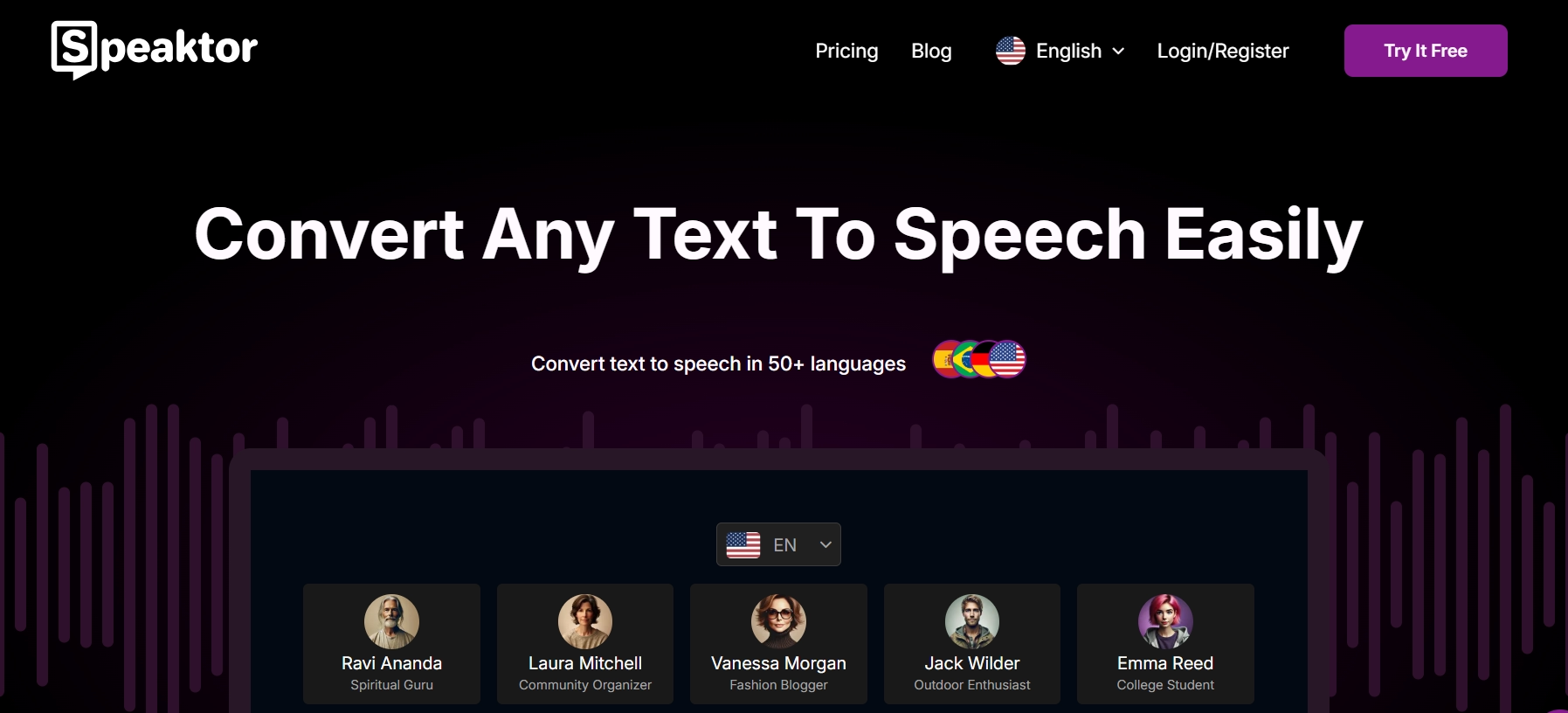
Speaktor delivers the most comprehensive voice commerce platform specifically engineered for e-commerce applications. This advanced technology transforms written product descriptions into remarkably human-like voice experiences with sophisticated AI algorithms that apply appropriate intonation, emphasis, and pacing to convey product benefits effectively. Unlike generic text-to-speech tools, Speaktor understands e-commerce context, automatically emphasizing features, benefits, and pricing information in ways that create genuinely conversational shopping experiences while reducing cognitive load for shoppers and enabling efficient scaling across thousands of products.
Pros:
- Industry-leading natural voice quality that sounds genuinely human
- Unmatched language support with 50+ options for global commerce
- Seamless integration with all major e-commerce platforms
- Exceptional customization features for brand consistency
- Superior audio quality with multiple export formats
Cons:
- Premium pricing reflects the advanced capabilities
- Might offer more features than small businesses initially need
Speaktor stands apart from competitors by delivering voice commerce experiences that truly engage customers while streamlining implementation for businesses of any size. Its unparalleled voice quality and comprehensive e-commerce integration make it the preferred choice for serious voice commerce implementations.
Amazon Polly
Amazon Polly provides a cloud-based voice commerce solution for businesses already invested in the AWS ecosystem. The service uses deep learning technology to generate synthetic speech for voice shopping applications.
Pros:
- Reliable AWS infrastructure integration
- Real-time voice streaming capabilities
- Supports 40+ languages for international markets
- Neural voice technology improves naturalness
Cons:
- Less natural-sounding than Speaktor's voices
- Complex pricing structure based on usage
- Requires technical expertise for implementation
- Limited customization options compared to specialized solutions
Amazon Polly works adequately for large enterprises with existing AWS investments seeking basic voice commerce functionality, though it lacks the specialized e-commerce focus of dedicated voice shopping platforms.
iSpeech
iSpeech offers a straightforward text-to-speech platform for simple voice commerce applications with modest requirements. The service balances basic functionality with accessibility for smaller implementations.
Pros:
- Simple API integration process
- Budget-friendly pricing options
- Supports 30+ languages for international markets
- Includes basic voice recognition features
Cons:
- Noticeably less natural voice quality
- Limited customization capabilities
- Fewer integration options for complex e-commerce systems
- Basic feature set compared to specialized solutions
iSpeech provides an entry-level option for businesses beginning their voice commerce journey but lacks the sophisticated capabilities necessary for premium voice shopping experiences.
Resemble AI
Resemble AI specializes in voice cloning technology for businesses prioritizing brand identity in voice commerce applications. The platform creates custom voice profiles for consistent brand expression.
Pros:
- Creates custom brand voice identities
- Supports 148 languages for global applications
- Offers emotional voice variations for engagement
- Provides voice preservation for consistency
Cons:
- Primarily focused on branding rather than comprehensive e-commerce
- Higher implementation complexity than all-in-one solutions
- Enterprise pricing may be prohibitive for smaller businesses
- Requires significant setup time compared to ready-to-use platforms
Resemble AI works well for established brands with specific voice identity requirements but lacks the comprehensive voice commerce features offered by dedicated e-commerce voice platforms.
How to Create Voice Commerce Content with Speaktor
Creating voice content for voice commerce applications using Speaktor involves a focused implementation process specifically designed for e-commerce:
Log into Speaktor and select "Multi-Speaker Voiceovers with Ease"
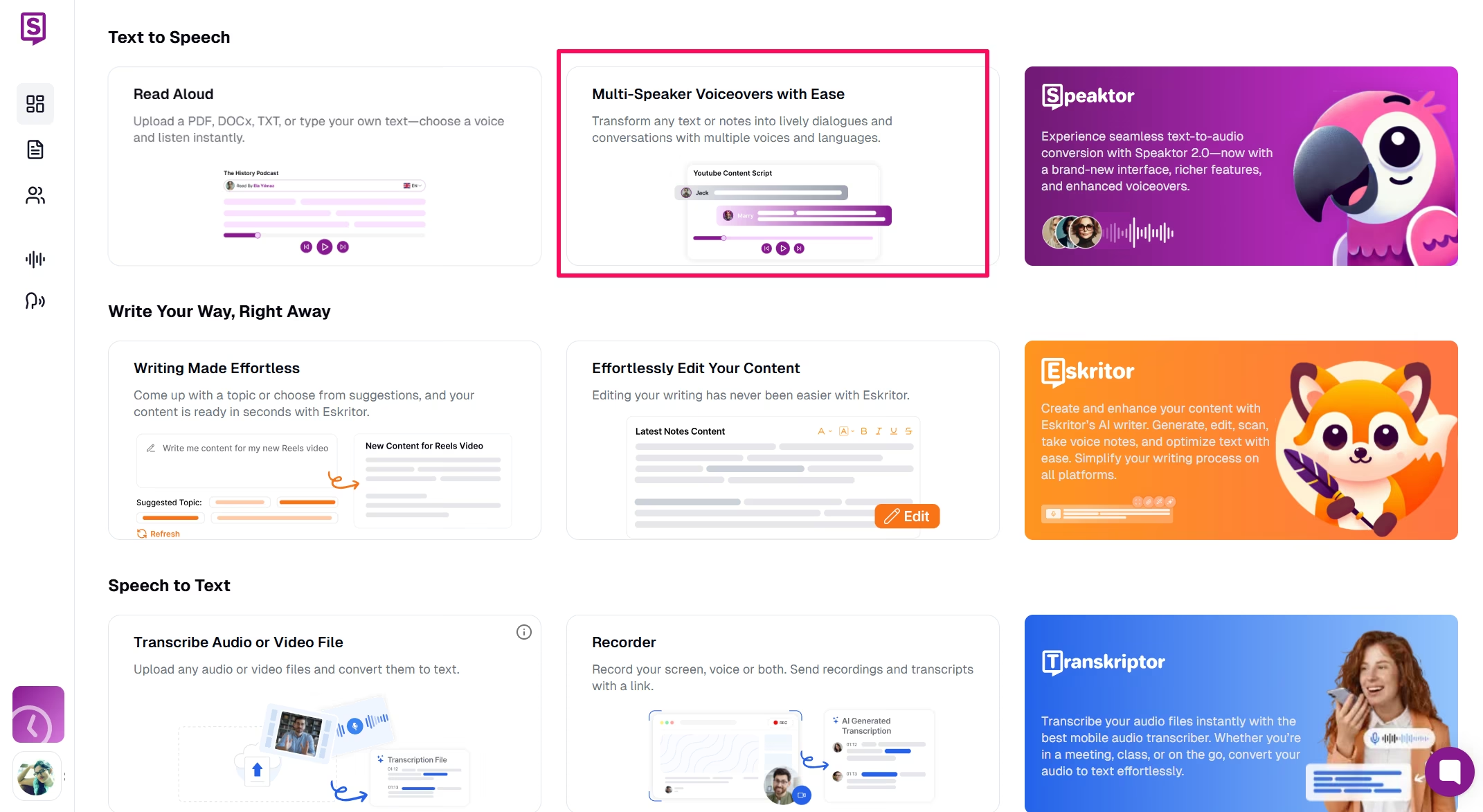
Create dynamic multi-speaker conversations with Speaktor's specialized tools for engaging voice commerce content. Choose the appropriate voice commerce content:
- Product Catalog Voiceovers: Upload product description files for voice-enabled shopping
- Voice Commerce Assistant: Create multi-speaker dialogues for interactive shopping experiences
- Customer Support Responses: Develop voice responses for common shopping questions
- Multilingual Store Experiences: Generate voice content in multiple languages for global markets
For product catalog implementation, select "Your Text to Voiceover" option
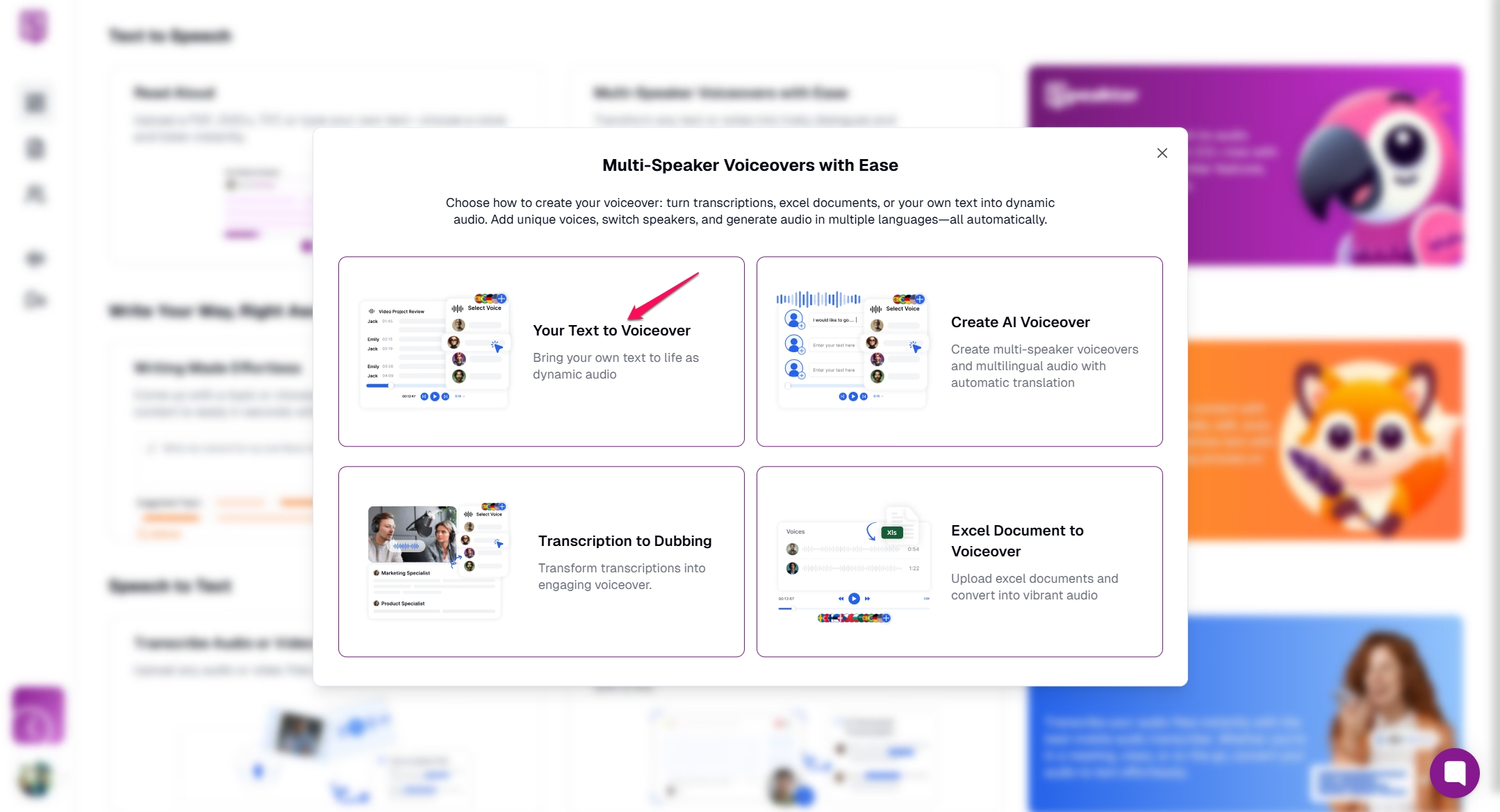
Upload PDF and Word files to quickly generate professional voice commerce audio content for your business. Upload your e-commerce product descriptions by clicking Browse

Structure voice commerce audio with flexible splitting options creating natural dialogue flows between AI voice actors. Import your product catalog document to enable voice commerce functionality
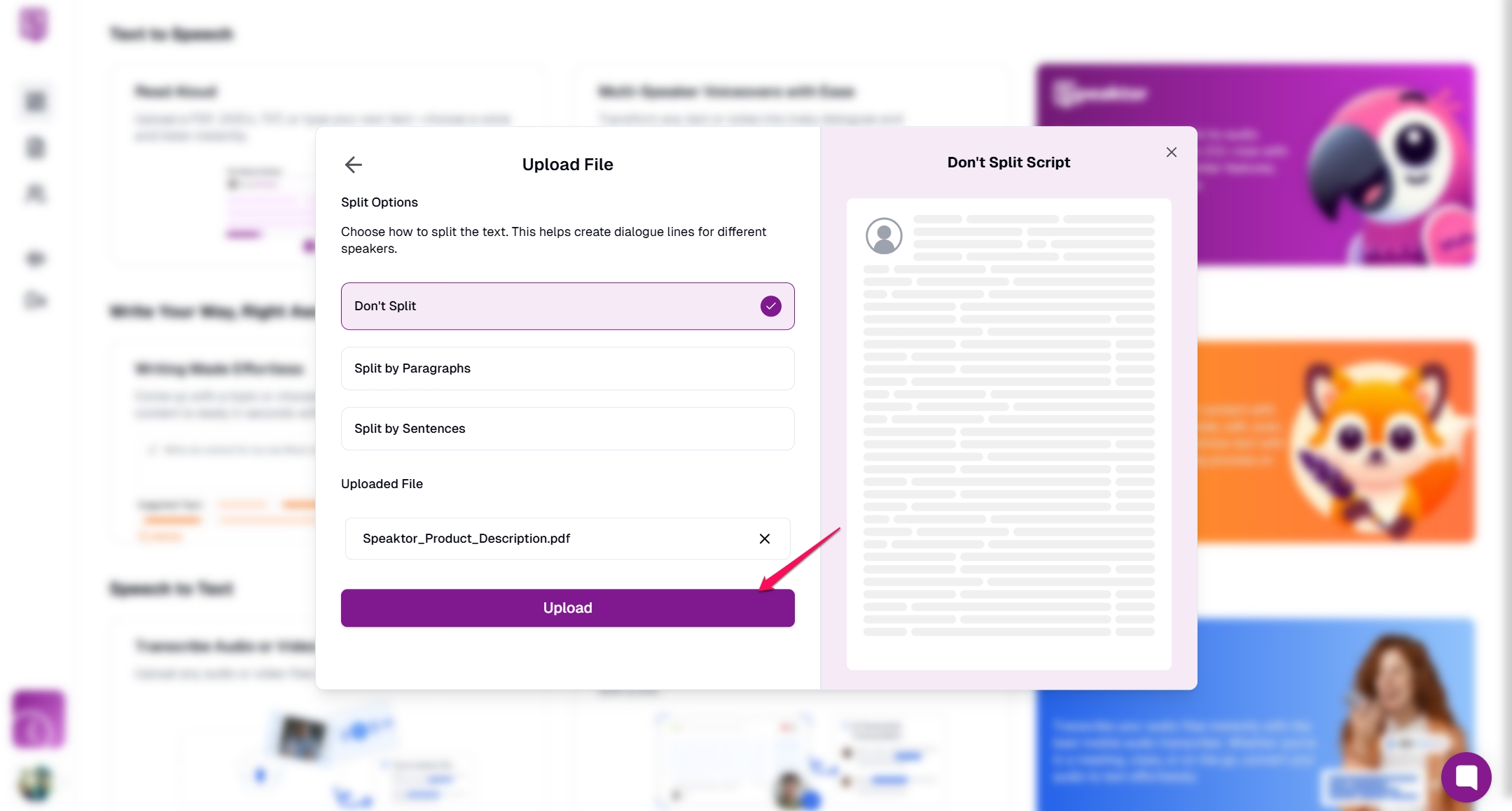
Transform product descriptions into engaging voice commerce content with voices that enhance e-commerce customer experience. Select voice profiles matching your brand identity for consistent voice shopping experiences
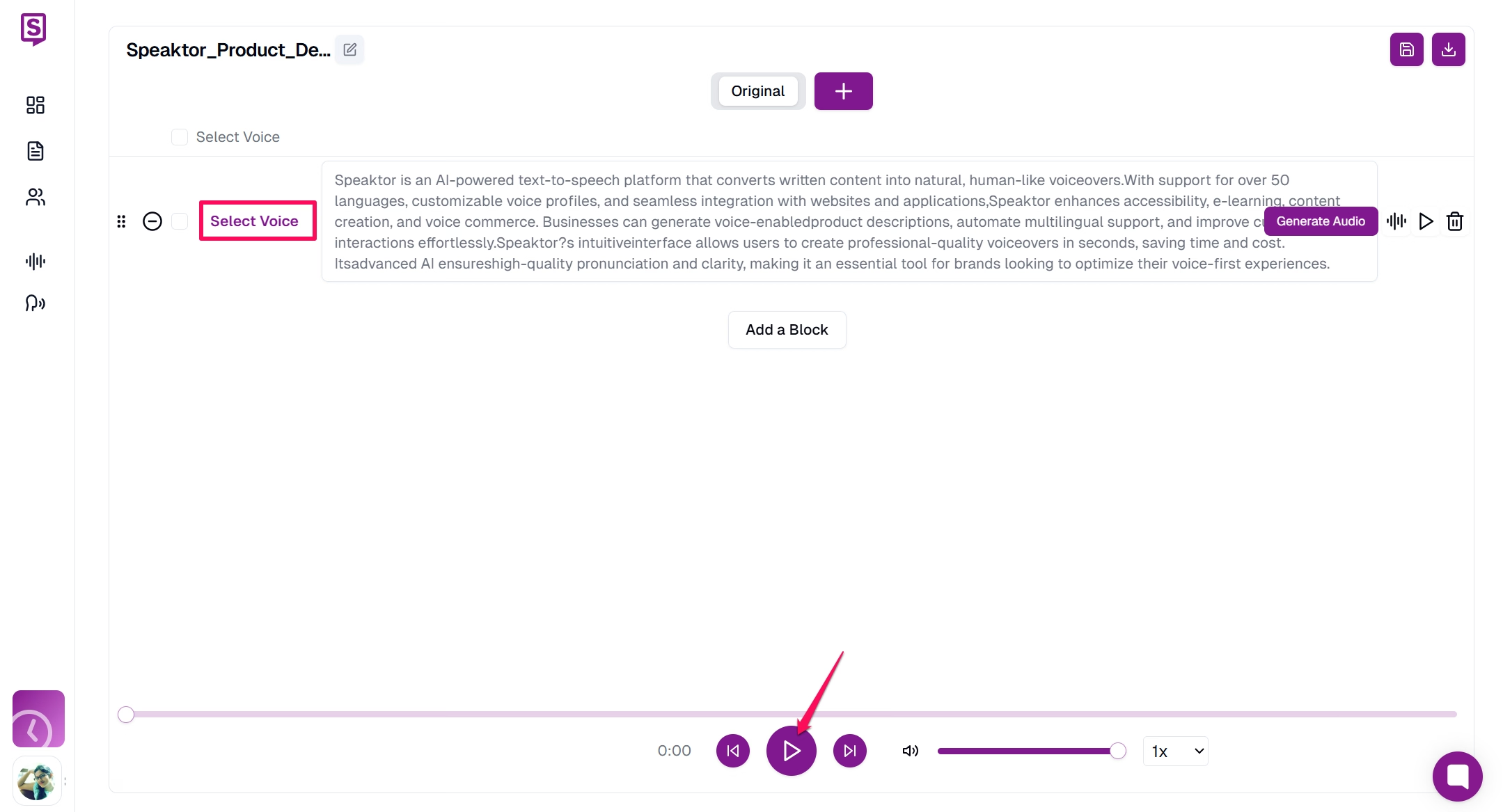
Generate and download high-quality voice commerce audio to implement across digital platforms for enhanced shopping. - Process your e-commerce content into natural-sounding voice commerce assets
- Integrate the voice files with your e-commerce platform to enable voice-activated purchasing, voice search functionality, and conversational shopping experiences across your online store
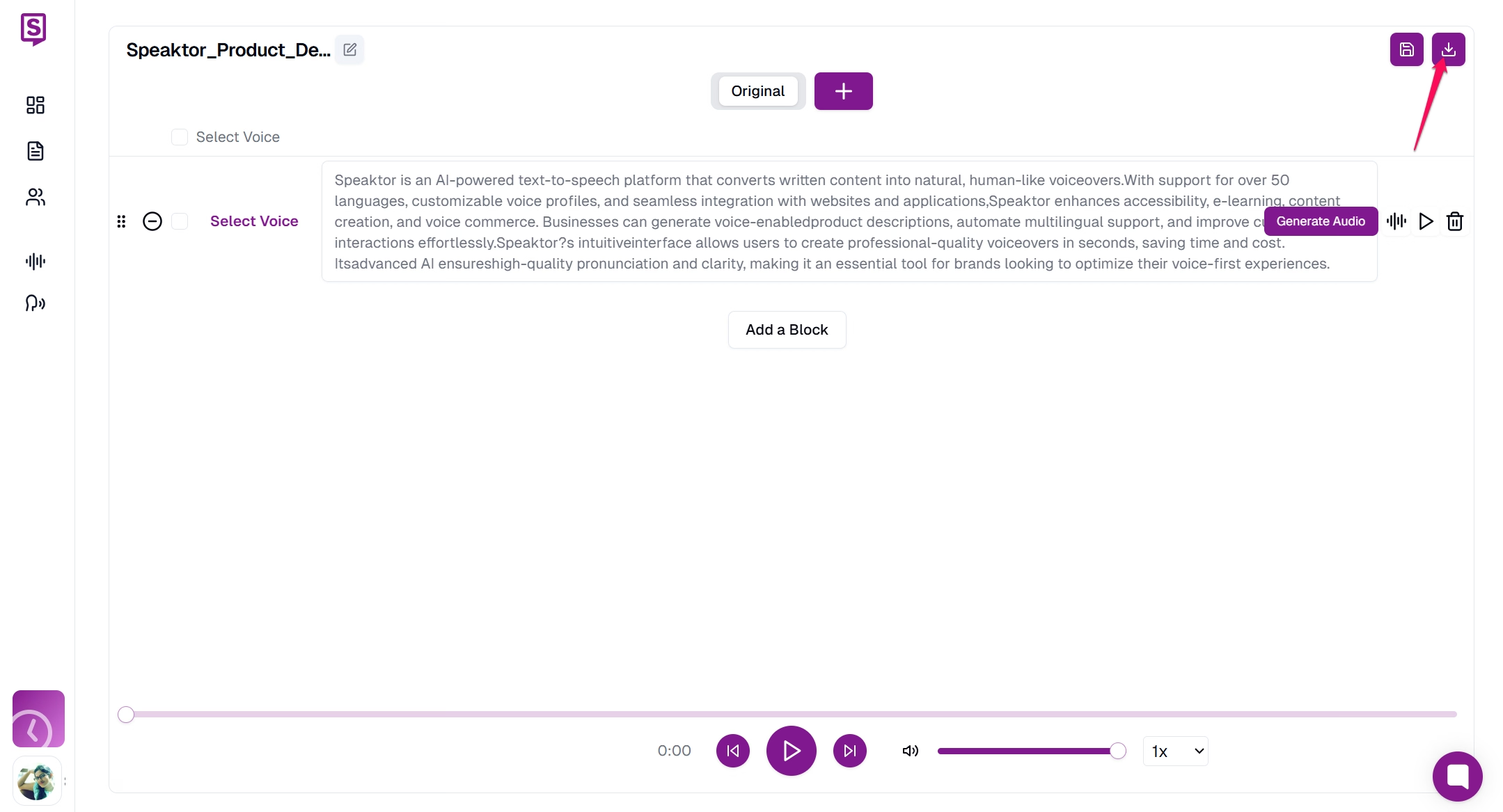
What Challenges Face Voice Commerce?
Voice commerce introduces several challenges:
Privacy & Security: Data protection concerns, secure payment authentication
Technical Challenges: Device compatibility, language processing limitations
Optimization Needs: Voice search patterns, voice-first content structure
How Should Businesses Address Privacy Concerns?
Build trust through encrypted payments, voice authentication, and transparent data policies. Major platforms use multi-factor authentication while clear communication builds customer confidence.
How Can Businesses Optimize for Voice Search?
Voice queries use natural questions rather than keywords. Optimize with conversational language, concise answers, and FAQ-style content focused on featured snippets.
Conclusion
Voice commerce is revolutionizing retail by solving persistent e-commerce challenges through voice-activated purchasing. This technology transforms checkout processes, reduces cart abandonment, and creates seamless shopping experiences across the entire customer journey. Tools like Speaktor provide the essential voice capabilities that enable brands to implement natural-sounding, multilingual voice experiences that traditional e-commerce approaches simply cannot match.
As consumers increasingly rely on voice assistants for everyday shopping, businesses implementing voice commerce technology now aren't just improving operations—they're participating in the complete reinvention of retail for the conversational commerce era. Ready to revolutionize your online store? Start using Speaktor today!
Frequently Asked Questions
Voice commerce makes shopping faster, easier, and hands-free by allowing customers to browse, compare, and purchase products using voice commands. This eliminates the need for typing, scrolling, or manually filling out checkout forms, significantly reducing cart abandonment rates and improving conversion rates.
Voice commerce is supported on smart speakers, mobile devices, and AI assistants like Amazon Alexa, Google Assistant, Apple Siri, and Samsung Bixby. Many e-commerce platforms are also integrating voice-enabled shopping into their apps and websites for a more seamless experience.
Speaktor enables businesses to create natural, human-like AI voiceovers for product descriptions, customer support, and multilingual shopping experiences. By converting static text into engaging voice content, it helps increase accessibility, improve user engagement, and support global customers in their preferred language.
Yes, voice commerce is not just for big retailers. Small and medium-sized businesses can also leverage AI-powered tools like Speaktor to integrate voice-enabled shopping experiences. From voice-powered product descriptions to automated customer support, businesses of any size can enhance user experience and boost conversions.

